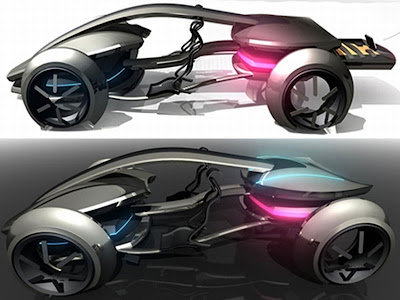




























 Savi Corporation's DynoValve Kit Packaging - The DynoValve takes the functioning of the mechanical Positive Crankcase Valve process and brings the process evolution to its maximum effectiveness. Image Credit: Edmund Jenks (2010)
Savi Corporation's DynoValve Kit Packaging - The DynoValve takes the functioning of the mechanical Positive Crankcase Valve process and brings the process evolution to its maximum effectiveness. Image Credit: Edmund Jenks (2010)MPG Track Day exhibit discovery leads to test!
Motor Press Guild's Track Day is a time each year where journalists who have a focus on transportation technology and culture come together with the major automobile manufacturers to find out what is new for the next year's (2011) selling season. Any company who believes they have something to contribute to the event and wish to gain exposure to 150 plus people who write and another 100 or so people who market transportation platforms may end up presenting their solutions as an exhibitor or sponsor to the event ... Savi Corporation was one such company.
After over a half a decade of research and development, testing, and working with various environmental agencies, Savi Corporation was able to introduce its "smart" Positive Crankcase Ventilation (PCV) valve to the world at last month’s 60th Pebble Beach Concours d'Elegance ... the DynoValve. The DynoValve replaces the mechanical PCV Valve found as original manufacture on all engines and takes the functioning of this environmentally useful process to a higher, more efficient level.
 Pictured - The DynoValve computer-controlled valve on top with the mechanical PCV valve on bottom. Image Credit: Edmund Jenks (2010)
Pictured - The DynoValve computer-controlled valve on top with the mechanical PCV valve on bottom. Image Credit: Edmund Jenks (2010)As an engine operates, high-pressure gases are contained within the combustion chamber and prevented from passing into the crankcase (containing the crankshaft and other parts) between the side of the piston and the cylinder bore by piston rings which seal against the cylinder. However, some amount of gas always leaks past the piston rings into the crankcase. This amount is very small in a new or properly rebuilt engine, provided that the piston rings and cylinder walls are correctly "broken in", and increases as the engine wears. Scratches on the cylinder walls or piston rings, such as those caused by foreign objects entering the engine, can cause large amounts of leakage. This leaked gas is known as blow-by because the pressure within the cylinders blows it by the piston rings. If this blow-by gas could not escape then pressure would build up within the crankcase.
Before the invention of crankcase ventilation in 1928, the engine oil seals were designed to withstand this pressure, oil leaking to the road surface was accepted, and the dipstick was screwed in. The hydrocarbon rich gas would then diffuse through the oil in the seals into the atmosphere. Subsequently, it became an emissions requirement as well as a functional necessity that the crankcase have a ventilation system. This [system] must maintain the crankcase at slightly less than atmospheric pressure under light load conditions and recycle the blow-by gas back into the engine intake.
However, due to the constant circulation of the oil within the engine, along with the high speed movement of the crankshaft, an oil mist is also passed through the PCV system and into the intake. The oil is then either burned during combustion, or settles along the intake tract, causing a gradual build-up of residue inside the inlet path. For this reason many engine tuners choose to replace the PCV system with an oil catch can and breather filter which vents the blow-by gases directly to atmosphere and retains the oil in a small tank (or returns it to the sump), although this technically fails to meet most engine emission legislation.
Reference Here>>
Many claims as to the benefits of this computerized DynoValve system process center around two major areas. It is GREEN and it makes one's vehicle more fuel efficient.
The DynoValve is GREEN because it allows for a greater, more complete burning of the fuel and other materials in the cylinder of the engine due to the increased breath-ability of the engine itself. The carbon particulate matter from the fuel and the gasses from the crankcase being more effectively burned, along with the catalytic converter, knocks the emissions to a nearly un-measurable level.
 The GREEN and fuel efficient Hummer H2 stretch limousine with DynoValve. Image Credit: Edmund Jenks (2010)
The GREEN and fuel efficient Hummer H2 stretch limousine with DynoValve. Image Credit: Edmund Jenks (2010)This begs the question "Can this be tested and an article be developed by one of the journalists who became aware of the DynoValve at MPG Track Day to show the results one might be able to achieve on an everyday pick-up truck?" The F250 "test-bed". Image Credit: Edmund Jenks (2010)
The F250 "test-bed". Image Credit: Edmund Jenks (2010)
The installation happened yesterday on a 1995 Ford F250 XLT, 7.5 litre/460 cubic inch V8 powered pick-up that had 55,488.6 original miles on it at the time of install. The truck pretty much averages 10 miles per gallon and there had been times the truck did achieve 12 mpg but these were times where one was traveling out of the San Bernardino Mountains and traveled on the freeway at reduced speeds.
It was discovered during the install procedure that there was a couple of breeches in the truck's vacuum hose array which had the pressure measuring around 17 lbs. (normal pressure is about 20 lbs.). After installation of the DynoValve and the replacement of the compromised hoses, the operation of the truck's PCV vacuum system was restored back to 20 lbs. (full slideshow here).
 Installed DynoValve. Image Credit: Edmund Jenks (2010)
Installed DynoValve. Image Credit: Edmund Jenks (2010)












 .
.